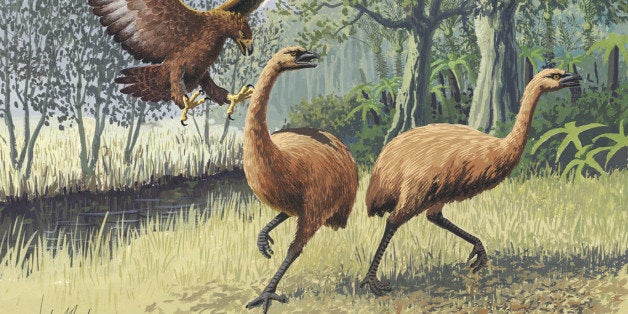
For millions of years, nine species of large, flightless birds known as moas (Dinornithiformes) thrived in New Zealand. Then, about 600 years ago, they abruptly went extinct. Their die-off coincided with the arrival of the first humans on the islands in the late 13th century, and scientists have long wondered what role hunting by Homo sapiens played in the moas’ decline. Did we alone drive the giant birds over the brink, or were they already on their way out thanks to disease and volcanic eruptions?
Now, a new genetic study of moa fossils points to humankind as the sole perpetrator of the birds’ extinction. The study adds to an ongoing debate about whether past peoples lived and hunted animals in a sustainable manner or were largely to blame for the extermination of numerous species.
“The paper presents a very convincing case of extinction due to humans,” says Carles Lalueza-Fox, an evolutionary biologist at the Institute of Evolutionary Biology in Barcelona, Spain, who was not involved in the research. “It’s not because of a long, natural decline.”
Scientists have long argued about what caused the extinction of many species of megafauna—giant animals including mammoths, mastodons, and moas—beginning between 9000 and 13,000 years ago, when humans began to spread around the world. Often, the animals disappeared shortly after humans arrived in their habitats, leading some researchers to suggest that we exterminated them by overhunting. But other scientists have pointed to natural causes, including volcanic eruptions, disease, and climate change at the end of last Ice Age, as the key reasons for these species’ demise. The moas present a particularly interesting case, researchers say, because they were the last of the giant species to vanish, and they did so recently, when a changing climate was no longer a factor. But did other natural causes set them on a path to oblivion, as some scientists proposed in a recent paper?
Morten Allentoft, an evolutionary biologist at the University of Copenhagen, doubted this hypothesis. Archaeologists know that the Polynesians who first settled New Zealand ate moas of all ages, as well as the birds’ eggs. With moa species ranging in size from 12 to 250 kilograms, the birds—which had never seen a terrestrial mammal before people arrived—offered sizable meals. “You see heaps and heaps of the birds’ bones in archaeological sites,” Allentoft says. “If you hunt animals at all their life stages, they will never have a chance.”
Using ancient DNA from 281 individual moas from four different species, including Dinornis robustus (at 2 meters, the tallest moa, able to reach foliage 3.6 meters above the ground), and radiocarbon dating, Allentoft and his colleagues set out to determine the moas’ genetic and population history over the last 4000 years. The moa bones were collected from five fossil sites on New Zealand’s South Island, and ranged in age from 12,966 to 602 years old. The researchers analyzed mitochondrial and nuclear DNA from the bones and used it to examine the genetic diversity of the four species.
Usually, extinction events can be seen in a species’ genetic history; as the animals’ numbers dwindle, they lose their genetic diversity. But the team’s analysis failed to find any sign that the moas’ populations were on the verge of collapse. In fact, the scientists report that the opposite was true: The birds’ numbers were stable during the 4000 years prior to their extinction, they report online today in the Proceedings of the National Academy of Sciences. Populations of D. robustus even appear to have been slowly increasing when the Polynesians arrived. No more than 200 years later, the birds had vanished. “There is no trace of” their pending extinction in their genes, Allentoft says. “The moa are there, and then they are gone.”
The paper presents an “impressive amount of evidence” that humans alone drove the moa extinct, says Trevor Worthy, an evolutionary biologist and moa expert at Flinders University in Adelaide, Australia, who was not involved with the research. “The inescapable conclusion is these birds were not senescent, not in the old age of their lineage and about to exit from the world. Rather they were robust, healthy populations when humans encountered and terminated them.” Still, he doubts even Allentoft’s team’s “robust data set” will settle the debate about the role people played in the birds’ extinction, simply because “some have a belief that humans would not have” done such a thing.
As for Allentoft, he is not surprised that the Polynesian settlers killed off the moas; any other group of humans would have done the same, he suspects. “We like to think of indigenous people as living in harmony with nature,” he says. “But this is rarely the case. Humans everywhere will take what they need to survive. That’s how it works.”
This story has been provided by AAAS, the non-profit sciencesociety, and its international journal,
